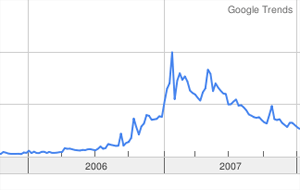Social media was one of the big stories in 2007, particularly in the marketing and PR space.
Large companies and agencies continued to explore opportunities in emerging channels, meeting with mixed results, Forrester predicted that spending on social media will grow to $6.9 billion over the next five years, a number surpassing their projects for both mobile and e-mail marketing.
Several newcomers emerged in the PR software/service field, focused on social media and many current providers like Vocus continue to focus on answering the questions social media poses.
In the space itself, users continued to migrate from the over-commodified and under-innovated MySpace to Facebook but the overall numbers seem stagnant, social bookmarking continues to be popular amongst a mostly niche audience, and in all likelihood, blogging has plateaued.
Gartner estimated that there were already more than 200 million ex-bloggers and that number probably will continue to grow rapidly over the next few years.
And oh yeah, Second Life seems to be dead (here is a little validation from Google trends).

Queries of ‘Second Life’ according to Google Trends
So what is going on?
My perspective is that to understand why social media is ostensibly stagnating, all we need to do is study the moniker itself…”social media.”
What is truly social about social media?
Thinking back on the mid-90s, we saw a variety of new forms of communications emerge that were oriented around the building of online communities – Usenet, listservs, bulletin board systems, MUDs. These were the predecssors to this new wave of social media we are currently seeing.
Accompanying these original forms of social media was a revolutionary school of thought that sociability was no longer constrained by physical barriers – new forms of social interactions would lead to the emergence of social communities online that would have a profound societal and global impact.
But the initial optimism that accompanied these new, innovative social forms became tempered when the limitations of online communities became manifest.
Most of the retrospective studies (many of which coincided with the crash) that explore the impact of the Internet on general sociability concluded that in isolation, the Internet did not serve to facilitate sustainable sociability by itself.
At the most, it could be a tool to facilitate sociability.
With the emergence of social media (a much better label than Web 2.0) during the past several years, we may not have vividly remembered all the lessons learned during the first revelation and perhaps got caught up in the excitement of blogs, social networks, and podcasts.
Looking forward to 2008
As we move into 2008, I believe we are going to continue tempering our expectations in the potential of social media and refocus. We may be experiencing a quick moment of disillusionment in its potential but it will be ephemeral because unlike the first go-around, we are wiser and more pragmatic in our perspective having gone through this once before.
Also, our initial expectations were not as revolutionary as the first time. This time around, we were more interested in working smarter and better, and integrating new media with traditional – rather than creating a brave new world.
In 2008 we are on the verge of entering an era of stability with social media in which the overblown excitement and optimism will quiet and we will see the very real and practical application of these new forms of technologies in our everyday lives and jobs.
In many ways, the political campaigns will show us the way. The manner in which they use social media to facilitate (and not replace) communications strategies is the right way. Blogging and social media aren’t going to replace things like television or radio advertising, much less print – but they will impact and engage with these traditional mediums.
The private sector will finally learn that social media isn’t simply a new channel to be monetized and leveraged, but rather embraced and interacted with. There are many opportunities in the social media space but they can’t all be purchased with money – many will have to be attained through actual commitment.
The traditional media will realize that social media has become inextricably interwoven with everything they do and they will stop looking down their noses (in partial fear) at bloggers and podcasters and start to learn how to work better with them.
Finally, the masses will continue to learn that they are no longer passive consumers of media. They don’t have to sit around and watch MTV anymore – rather, they can actually pick up their camera and create their own media. Hopefully, Hollywood executives and producers will have to become more accountable for the quality of content they produce because their audiences are continuing to become empowered.
So, where does that leave the social media entities themselves?
I’ll leave that for next week 🙂
1 Comment on "Social media outlook for 2008"
Elenora Harnett
May 17, 2017Love the content. Keep up the good work.